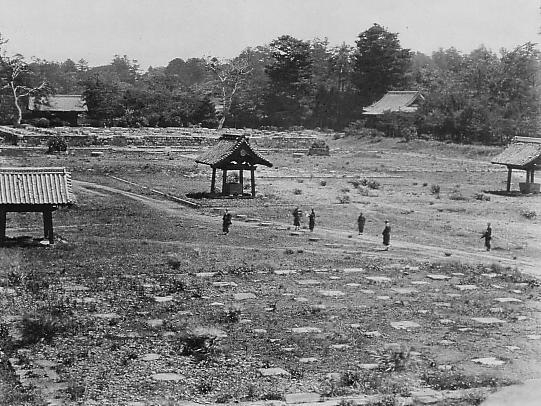Battle of Ueno on:
[Wikipedia]
[Google]
[Amazon]
The was a battle of the
/ref>
 The Shōgitai took up positions around
The Shōgitai took up positions around  ''Rinnōji no Miya'' escaped, reached Enomoto Takeaki's warship ''Chogei-maru'' and was dropped off further north, on the Pacific coast. Harada Sanosuke of the
''Rinnōji no Miya'' escaped, reached Enomoto Takeaki's warship ''Chogei-maru'' and was dropped off further north, on the Pacific coast. Harada Sanosuke of the 

Boshin War
The , sometimes known as the Japanese Revolution or Japanese Civil War, was a civil war in Japan fought from 1868 to 1869 between forces of the ruling Tokugawa shogunate and a clique seeking to seize political power in the name of the Imperi ...
, which occurred on July 4, 1868 (''Meiji 1, 15th day of the 5th month''), between the troops of the Shōgitai under Shibusawa Seiichirō and Amano Hachirō, and Imperial "Kangun" troops.
Prelude
Though the Shōgitai was mostly made up of former Tokugawa retainers and residents of the surrounding provinces, some domains supported the Shōgitai, such as Takada ''han'' (Echigo Province, 150,000 ''koku''), Obama ''han'' (Wakasa Province, 103,000 ''koku''), Takasaki ''han'' (Kōzuke Province, 52,000 ''koku''), and Yūki ''han'' (Shimosa Province, 18,000 ''koku''). Facing them were the combined forces of the Chōshū,Ōmura Omura (小村) or Ōmura (大村) are Japanese surnames, but may also refer to:
* Ōmura, Nagasaki, a city located in Nagasaki Prefecture, Japan
* Omura's whale (''Balaenoptera omurai''), a species of rorqual about which very little is known
People ...
, Sadowara, Hizen, Chikugo, Owari, Bizen, Tsu, Inaba, and Higo Higo may refer to:
* Higo Province, old province in what is now Kumamoto Prefecture, Japan
* Higo Ko-ryu, Japanese koryū martial art
* Higo Magalhães (born 1982), Brazilian football manager and former defensive midfielder
* Higo (footballer) ...
domains, under the general command of Chōshū's Ōmura Masujirō
was a Japanese military leader and theorist in Bakumatsu period Japan. He was the "Father" of the Imperial Japanese Army, launching a modern military force closely patterned after the French system of the day.
Early life and education
Ōmura ...
.
Shibusawa and Amano initially had the 2000-strong Shōgitai posted in Ueno to protect Tokugawa Yoshinobu, who was, at the time, in self-imposed confinement at Ueno's Kan'ei-ji Temple, as well as Prince Rinnōji no Miya Yoshihisa, who was the abbot of the temple, and was to become the new dynastic leader of the Tokugawa resistance as "Emperor Tōbu".
From their base, the Shogitai had been harassing Imperial troops, creating trouble in Edo, thus forcing the Imperial side, although outnumbered, to take action.''The last samurai'' Mark Ravina p.157/ref>
Battle
 The Shōgitai took up positions around
The Shōgitai took up positions around Kan'ei-ji
(also spelled Kan'eiji or Kaneiji) is a Tendai Buddhist temple in Tokyo, Japan, founded in 1625 during the Kan'ei era by Tenkai, in an attempt to emulate the powerful religious center Enryaku-ji, in Kyoto. The main object of worship is .Ni ...
(寛永寺; an important Tokugawa family temple) and the nearby Nezu Shrine (根津神社).Yamakawa Kenjirō. ''Aizu Boshin Senshi'' Tōkyō: Tōkyō Daigaku Shuppankai, 1931, p. 196. When the battle began, the forces of Satsuma, led by Saigō Takamori
was a Japanese samurai and nobleman. He was one of the most influential samurai in Japanese history and one of the three great nobles who led the Meiji Restoration. Living during the late Edo and early Meiji periods, he later led the Sats ...
, attacked head-on at the gate, but were stopped by the ''Shogitai'' forces, which were superior in number. The Satsuma forces suffered heavy casualties, until the forces of Choshu managed to make a second attack from the rear, which unblocked the tactical stalemate. While the Shogitai put up stiff resistance, the Tosa troops also used Armstrong Armstrong may refer to:
Places
* Armstrong Creek (disambiguation), various places
Antarctica
* Armstrong Reef, Biscoe Islands
Argentina
* Armstrong, Santa Fe
Australia
* Armstrong, Victoria
Canada
* Armstrong, British Columbia
* Armstrong, ...
cannons and Snider guns to devastating effect, thus ending the last center of resistance in Edo. According to Saigō Takamori:
Shinsengumi
The was a special police force organized by the (military government) during Japan's Bakumatsu period (late Tokugawa shogunate) in 1863. It was active until 1869. It was founded to protect the shogunate representatives in Kyoto at a time w ...
is said to have joined the Shōgitai, and died soon after this battle.Kikuchi Akira. ''Shinsengumi Hyakuichi no Nazo''. Tokyo: Shin Jinbutsu Oraisha, 2000, pp. 228–229. About 300 Shogitai are said to have died in the battle, and a thousand houses were burnt in collateral damages.

References
{{ReflistFurther reading
*Kikuchi Akira. ''Shinsengumi Hyakuichi no Nazo''. Tōkyō: Shin Jinbutsu Ōraisha, 2000. *Mori Mayumi. ''Shōgitai Ibun''. Tōkyō: Shinkōsha, 2004. *Steele, M. William. ''Against the Restoration. Katsu Kaishu's Attempt to Reinstate the Tokugawa Family''. ''Monumenta Nipponica'', Vol. 36, No. 3. (Autumn, 1981), pp. 299–316. *Steele, M. William. ''Edo in 1868: The View from Below''. ''Monumenta Nipponica'', Vol. 45, No. 2. (Summer, 1990), pp. 127–155. *Takano Kiyoshi. ''Tokugawa Yoshinobu: Gendai Nihon no Enshutsusha''. Tōkyō: Nihon Hōsō Shuppan Kyōkai, 1997. *Yamakawa Kenjiro. ''Aizu Boshin Senshi''. Tokyo: Tokyo Daigaku Shuppankai, 1931. 1868 in Japan Boshin War Ueno Ueno Ueno, Tokyo Ueno July 1868 events Incidents in the history of Buddhism in Japan